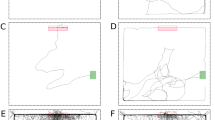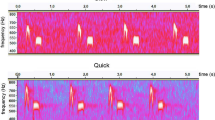Summary
In a field population of Gryllus campestris, 209 males and 175 females were marked individually and their migratory and mating behavior was observed. Many females and males mate more than once and both sexes change burrows frequently. All copulations observed were during the day. Automatic recording of calling in 12 selected males, and walking in 7 females, showed that an individual male may call predominantly during the day, during the night, or both day and night, but the females show locomotory activity predominantly during the day. Thus, female locomotion is significantly temporally correlated with copulation but not with male calling.
Similar content being viewed by others
References
Alexander RD (1961) Aggressiveness, territoriality, and sexual behaviour in field crickets. Behaviour 17:130–223
Cade W (1981) Field cricket spacing, and the phonotaxis of crickets and parasitoid flies to clumped and isolated cricket songs. Z Tierpsychol 55:289–384
Campbell DJ, Shipp E (1979) Regulation of spatial pattern in populations of the field cricket Teleogryllus commodus (Walker). Z Tierpsychol 51:260–268
Elsner N, Popov AV (1978) Neuroethology of acoustic communication. Adv Insect Physiol 13:229–335
Evans AR (1983) A study of the behaviour of the Australian field cricket Teleogryllus commodus (Walker) (Orthoptera: Gryllidae) in the field and in habitat simulations. Z Tierpsychol 62:269–290
Gerhardt U (1913) Copulation und Spermatophoren von Grylliden und Locustiden. Zool Jb Syst 35:415–532
Hedrick AV (1986) Female preferences for male calling bout duration in a field cricket. Behav Ecol Sociobiol 19:73–77
Honegger HW (1981) Three different diel rhythms of the calling song in the cricket, Gryllus campestris, and their control mechanisms. Physiol Entomol 6:289–296
Huber F (1955) Sitz und Bedeutung nervöser Zentren für Instinkthandlungen beim Männchen von Gryllus campestris L. Z Tierphysiol 12:12–48
Huber F (1977) Lautäußerungen, und Lauterkennung bei Insekten (Grillen). Rhein-Westf Akad Wiss, Vorträge N 265:15–66
Loher W (1972) Circadian control of stridulation in the cricket Teleogryllus commodus Walker. J Comp Physiol 79:173–190
Loher W (1979a) Circadian rhythmicity of locomotor behavior and oviposition in female Teleogryllus commodus. Behav Ecol Sociobiol 5:253–262
Loher W (1979b) The effect of male calling on female locomotor activity of Teleogryllus commodus. Behav Ecol Sociobiol 5:383–396
Loher W, Orsak LJ (1985) Circadian patterns of premating behaviour in Teleogryllus oceanicus Le Guillou under laboratory and field conditions. Behav Ecol Sociobiol 16:223–231
Popov AV (1972) Acoustic signals emitted by crickets (Orthoptera, Gryllidae) in southern european regions of the USSR. Entomol Rev 51:17–36
Popov AV (1975) Acoustic behavior and migration of field crickets, Gryllus campestris. Zool J 54:1803–1809 [in Russian]
Popov AV, Shuvalov VF (1977) Phonotactic behavior of crickets. J Comp Physiol 119:111–126
Popov AV, Shuvalov FJ, Svetlogorskaya LD, Markovich AM (1974) Acoustic behavior and auditory system in insects. Rhein-Westf Akad Wiss 53:281–306
Sakaluk SK (1987) Reproductive behavior of the decorated cricket, Gryllodes supplicans (Orthoptera: Gryllidae): calling schedules, spatial distribution, and mating. Behaviour 100:202–225
Sakaluk SK, Belwood JJ (1984) Gecko phonotaxis to cricket calling song: a case of satellite predation. Anim Behav 32:659–662
Sakaluk SK, Cade W (1980) Female mating frequency and progeny production in singly and doubly mated house and field crickets. Can J Zool 58:404–411
Simmons LW (1986) Female choice in the field cricket Gryllus bimaculatus (De Geer). Anim Behav 34:1463–1470
Thorson J, Weber T, Huber F (1982) Auditory behavior of the cricket. II. Simplicity of calling-song recognition in Gryllus, and anomalous phonotaxis at abnormal carrier frequencies. J Comp Physiol 146:361–378
Walker TJ (1983) Diel patterns of calling in nocturnal Orthoptera. In Gwynne DT, Morris GK (eds) Orthopteran mating systems. Westview, Boulder, pp 45–72
Weber T, Thorson J, Huber F (1981) Auditory behavior of the cricket. I. Dynamics of compensated walking and discrimination paradigms on the Kramer treadmill. J Comp Physiol 141:215–232
Author information
Authors and Affiliations
Rights and permissions
About this article
Cite this article
Rost, R., Honegger, H.W. The timing of premating and mating behavior in a field population of the cricket Gryllus campestris L.. Behav Ecol Sociobiol 21, 279–289 (1987). https://doi.org/10.1007/BF00299965
Received:
Accepted:
Issue Date:
DOI: https://doi.org/10.1007/BF00299965




